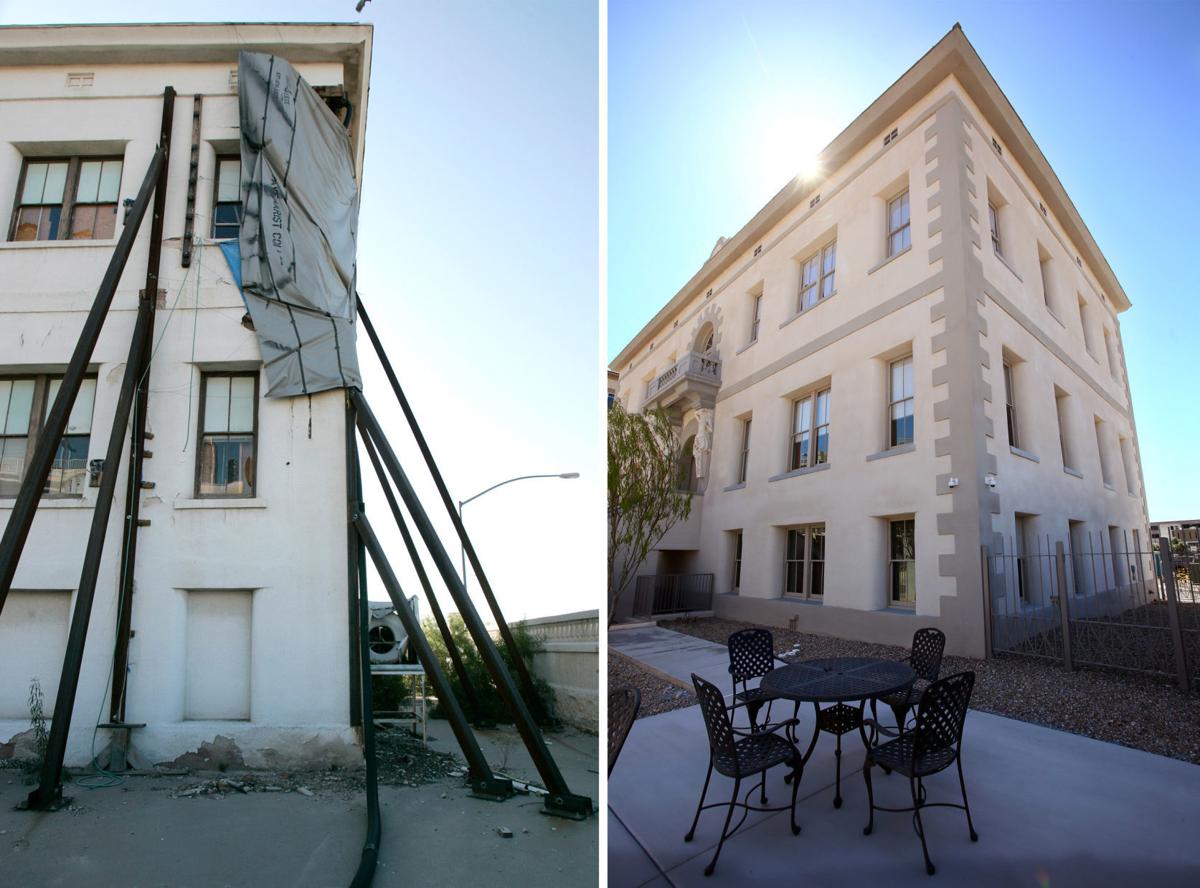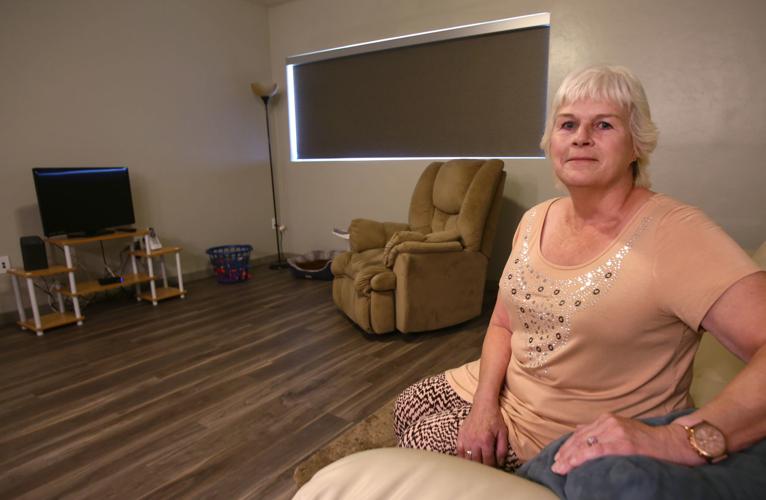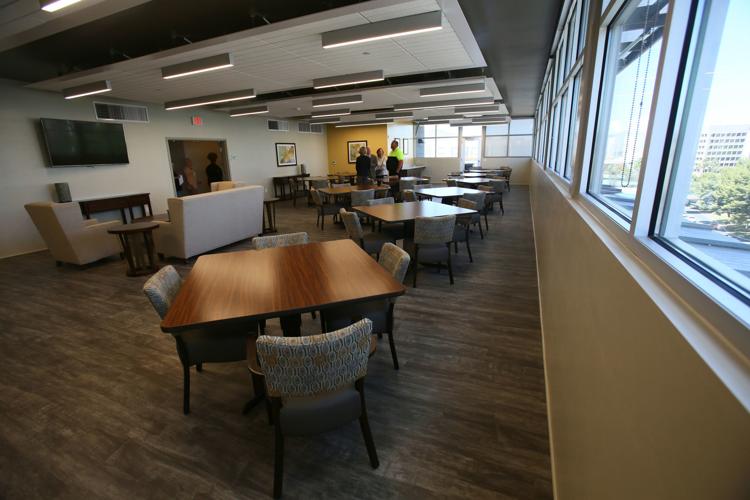The Marist on Cathedral Square, a $25 million project featuring 83 units in an affordable senior living community downtown, debuted Thursday.
And, before its debut, the new apartments on two sites on Church Avenue, south of Broadway, were a hit. There are no vacancies, officials said.
It took about a decade of planning and a partnership of government entities, the Roman Catholic Diocese of Tucson, multiple levels of financing and community support for Marist on Cathedral Square apartments to come to fruition, said Richard Elías, chairman of the Pima County Board of Supervisors.
A catalyst for the project was to save the historic 1915 Marist College building designed by Bishop Henry Regis Granjon.
adobe structure
Marist College started as a parochial boys school that had boarders as well as students who attended daily classes from elementary grades to high school sophomores. It also was the city’s first integrated school, long before public schools were desegregated in the early 1950s, according to a 2017 Star article.
People are also reading…
The Marists, a religious order, operated the school until 1924, when it was taken over by the Sisters of St. Joseph and, later, the Daughters of the Immaculate Heart. Then the school became open to girls and boys of all races. The school closed in 1968 and the building was converted into office space for the diocese until 2002, when it was found to be structurally compromised and was vacated.
The building is the only existing three-story mud adobe structure in the state. Before it was converted into eight apartments for low-income seniors, it was falling apart behind St. Augustine Cathedral on South Stone Avenue.
Renovations began in 2017, and now the Marist College has eight one-bedroom units, and to the north on the corner of Church and Broadway is Marist Midrise, a seven-story new building with 75 units — 10 having two-bedrooms. Both complexes make up The Marist on Cathedral Square.

At Marist Midrise, a new housing complex at at 111 S. Church Ave., Barbara Allen, 66, lives with her 8-year-old Chihuahua.
“Tremendous need” for affordable housing
The project serves older people ages 62 and above, providing affordable housing that is based on income eligibility. Rent for a one-bedroom apartment could range from slightly above $400 on up, with two-bedroom units going for about $500 to $795.
“There is a tremendous need for affordable housing in Tucson, especially among the elders,” said Elías, adding that renovations and new developments downtown are creating new housing and attracting businesses.
“I love this area,” said Barbara Allen, 66, who gave a tour of her one-bedroom apartment at Marist Midrise. The retired nurse lives there with Toes, an 8-year-old Chihuahua.
“I am living on Social Security and I need affordable housing,” said Allen, praising the nonprofit Foundation for Senior Living, which developed the properties at 111 S. and 235 S. Church Ave.
Allen said she does not own a vehicle, but lives on the bus and streetcar routes. She walks and also is provided transportation by the complex for weekly grocery shopping.
The buildings are smoke-free, and rent includes utilities, except for cable and phone. Free amenities include an intercom system, security system, laundry facilities and a computer center.
Also included are a spacious community room with a full kitchen for events and celebrations, and space on the rooftop at Marist Midrise. The complex also has a fitness room and some resident parking.
Residents are offered free membership at the nearby Armory Park Senior Center. Other free activities include financial literacy classes, computer training, wellness classes and blood pressure and health screenings.

The just-opened Marist on Cathedral Square apartments on South. Church Street provide affordable housing to older residents.
Opens with waiting list
Steve Hastings, chief of real estate services for Foundation for Senior Living, said he has seen a huge impact on the need for affordable housing over the last 10 years. He said back then a typical development had 10 to 30 people on a waiting list, and now it is 300 to 400.
Hastings said before 2008, prospective tenants had a pension, Social Security, savings and owned a vehicle, but now many just have Social Security to live on.
The project was funded by Pima County general obligation bonds, the Rio Nuevo Tax Increment Finance District, and the county also helped the project qualify for major tax credit funding from the state Department of Housing, said officials.
Other funding sources included low-income housing tax credits and funding from the Federal Home Loan Bank of San Francisco Affordable Housing Program.
Photos: Renovation of Marist College and affordable apartment construction
Marist College

2012: Steel beams and heavy plastic wrap hold up the northwest corner of the Marist College in Tucson. 2019: New structural steel supports the building and the facade repaired by Tellez Masonry at the opening of Marist at Cathedral Square apartments.
Marist College

2012: The entrance into the Marist College on the campus of the Tucson Diocese. 2019: The renovated entrance and facade of the Marist at Cathedral Square affordable living apartments.
Marist College

John C. Shaheen, the property and insurance manager with the Roman Catholic Church's Diocese of Tucson stands outside the room in the old Marist College on Ochoa and Church after the northwest corner of the building collapsed on August 10, 2005. La Placita can be seen in the background. Water from recent rains may have weakened the unfired adobe in the building which was constructed in 1915, Shaheen said. The building's outer layer had cracked over the years exposing the adobe making it susceptible to the elements, he said.
Marist College

26 MARIST BS p1--An exterior shot of the Marist College Friday July 25, 2008,cq,(FRIDAY JULY 25, 2008) to go with a story about the city is close to an agreement with the Catholic Church to take it over and stabilize before it falls down. The city will foot the $1.3 million cost and the church will kick in $250,000 through a fund raising campaign. It is unclear what the city wants to do with it once it is fixed up. Photo by Benjie Sanders/Arizona Daily Star. digital #141354. MANDATORY CREDIT. NO MAG, NO SALES.
Marist on Cathedral Square

Marist on Cathedral Square apartments at 235 S. Church St. in Tucson on April 11, 2019
Marist on Cathedral Square

Marist on Cathedral Square apartments at 235 S. Church St. in Tucson on April 11, 2019
Marist on Cathedral Square

Reclaimed wood posts in the community room at the base of the Marist on Cathedral Square apartments at 235 S. Church St. in Tucson on April 11, 2019
Marist on Cathedral Square

People tour an apartment at Marist on Cathedral Square apartments at 111 S. Church St. in Tucson on April 11, 2019
Marist on Cathedral Square

The view from the 7th floor patio at Marist on Cathedral Square apartments at 111 S. Church St. in Tucson on April 11, 2019
Marist on Cathedral Square

The 7th floor community room at Marist on Cathedral Square apartments at 111 S. Church St. in Tucson on April 11, 2019
Marist College

Workers on on the north face of the building during the restoration and renovation of the Marist College on January 23, 2018.
Marist at Cathedral Square

The Marist at Cathedral Square under construction in downtown Tucson on Jan. 12, 2018.
Marist College

Work continues on the top floor of the Marist College continues as renovation are being made on the old buildng in Tucson on Sept. 7, 2017. The two-story adobe structure built in 1915, is being renovated to accomodate seniors along with a nearby complex.
Marist College

The south tower of the St Augustine Cathedral is nearly silhouetted as a worker with Southwest Hazard Control walks along the scaffolding of the Marist College which is enclosed for asbestos abatement in Tucson on Sept. 7, 2017. The two-story adobe structure built in 1915, is being renovated to accomodate seniors along with a nearby complex.
Marist College

Adobe bricklayers work on the northwest corner of the Marist College patching up the gaping hole left from a collapse of the corner in 2005 as the renovation of the building continues in Tucson on Sept. 7, 2017. The two-story adobe structure built in 1915, is being renovated to accomodate seniors along with a nearby complex.
Marist College

Working several stories in the air, Jose Meza, with Tellez Masonry, adds mortar to a new adobe brick he replaced on the damaged Marist College as work continues behind the St Augustine Cathedral on South Church Avenue and West Ochoa Street in Tucson on Sept. 5, 2017. The two-story adobe structure built in 1915, is being renovated to accomodate seniors along with a nearby complex.
Marist College

Steel beams are lined up on the street while another is raised over the Marist College continues on South Church Avenue and West Ochoa Street in Tucson on Sept. 18, 2017. The beams went into the building vertically and then horizontally to secure the building. The two-story adobe structure built in 1915, is being renovated to accomodate seniors along with a nearby complex.
Marist College

Victor Molina, with Tellez Masonry, applies a layer of lime plaster to the exterior of the Marist College as restoration continues on the building on South Church Avenue and West Ochoa Street in Tucson on Sept. 18, 2017. The lime plaster is meant to preserve the adobe bricks that were damaged after years of neglect. The two-story adobe structure built in 1915, is being renovated to accomodate seniors along with a nearby complex.
Marist College

Dust rises as Jose Verdugo, a worker with Tofel Dent Construction, pushes broken concrete out of his way in the basement of the Marist College on South Church Avenue and West Ochoa Street in Tucson on Sept. 18, 2017. Verdugo had to hammer out the concrete at the corner of the foundation so the steel beam would be able to fit properly in place.
Marist College

Workers continue demolishing the eastside addition of the Marist College in Tucson on Oct. 19, 2017, where a stairway and elevator is scheduled to be erected. It was added on to the building and his therefore not historical. In its place is going to be a stairway and elevator. The two-story adobe structure built in 1915, is being renovated to accomodate seniors along with a nearby complex.
Marist College

Workers continues on the eastside section of the Marist College in Tucson on Nov. 6, 2017, where a stairway and elevator is scheduled to be erected. It was added on to the building and his therefore not historical. In its place is going to be a stairway and elevator. The two-story adobe structure built in 1915, is being renovated to accomodate seniors along with a nearby complex.
Marist College

With the Marist College in the background, Luis Cantu, with Tellez Masonry gets ready to mix some lime putty to add to white cement and sand to make mortar as the renovation continues behind the St Augustine Cathedral on South Church Avenue and West Ochoa Street in Tucson on Sept. 5, 2017.
Marist College

Once out of the forms the crew from Tellez Masonry in Oro Valley, Ariz., let the mud adobe bricks dry in the sun which will be used for the restoration of the Marist College on August 14, 2017. The historic type bricks are composed of straw, native soil, silt, clay and sand, said owner Brian Tellez. When put together correctlly you can tell its the right mixture by the feel of it, he said. The bricks, which will weigh close to 50 pounds each, are 14 inches wide, 16 inches long and four inches thick, Tellez said. In one day the crew can make as many as 300-400 bricks a day and will need some 5,000 bricks for the restoration project, he said.
Marist College

Using a wooden form, Ramon Castro, left, and Luis Cantu with Tellez Masonry in Oro Valley, Ariz., make mud adobe bricks for the restoration of the Marist College on August 14, 2017. The historic type bricks are composed of straw, native soil, silt, clay and sand, said owner Brian Tellez. When put together correctlly you can tell its the right mixture by the feel of it, he said. The bricks, which will weigh close to 50 pounds each, are 14 inches wide, 16 inches long and four inches thick, Tellez said. In one day the crew can make as many as 300-400 bricks a day and will need some 5,000 bricks for the restoration project, he said.
Marist College

The Marist College is partially covered with sheeting as Southwest Hazard Control continues with lead and asbestos abatement behind the St Augustine Cathedral on South Church Avenue and West Ochoa Street in Tucson on Sept. 7, 2017. The two-story adobe structure built in 1915, is being renovated to provide affordable housing for seniors along with a nearby complex.
Marist College

The Marist College, a crumbling two-story adobe building that is being converted into apartments for low-income seniors, is currently being renovated in Tucson on July 13, 2017.
Marist College

In the basement, wet concrete lays at the base where a steel pillar will be placed to shore up the Marist College, a multi-story adobe building that was constructed in 1915 which is being renovated in downtown Tucson, on July 27, 2017. The Foundation for Senior Living is constructing eight units for senior housing in Marist that will include a community center in the existing basement.
Marist College

A worker emerges from a sealed passagway during asbestos removal at the Marist College, a multi-story adobe building that was constructed in 1915 and is being renovated in downtown Tucson, on July 27, 2017. The Foundation for Senior Living is constructing eight units for senior housing in Marist that will include a community center in the existing basement.
Marist College

In the basement, Manuel Silva and Rob Deemer with Preferred Concrete Pumping, Inc., struggle to unclog a heavy hose as they prepare to shoot concrete into the base of the Marist College, a multi-story adobe building that was constructed in 1915 that is being renovated in downtown Tucson, on July 27, 2017. The Foundation for Senior Living is constructing eight units for senior housing in Marist that will include a community center in the existing basement.
The Marist at Cathedral Square.jpg

Work continues on The Marist at Cathedral Square on Oct 19, 2017 at the former site of the adminstrative offices for the Roman Catholic Diocese of Tucson on Church Avenue and Broadway Boulevard which are being converted to a seven story facility for senior housing. The Foundation for Senior Living bought the center for $2.5 million and will have 75 units. It is located on the site of the former offices of Roman Catholic Diocese of Tucson.
Marist College

Working with a clean slate, the Marist College Square project is located at the former site of the Roman Catholic Diocese offices on West Broadway Boulevard and South Church Avenue. It is where a new building is being constructed and made into apartments for low-income seniors in Tucson on July 13, 2017.
Marist College

John Shaheen, property director for the Diocese checking out one of the badly damaged corner rooms of the Marist College during a tour on February 2, 2012.
Marist College

The basement of the Marist College on February 2, 2012.
Contact reporter Carmen Duarte at cduarte@tucson.com or 573-4104. On Twitter: @cduartestar
















